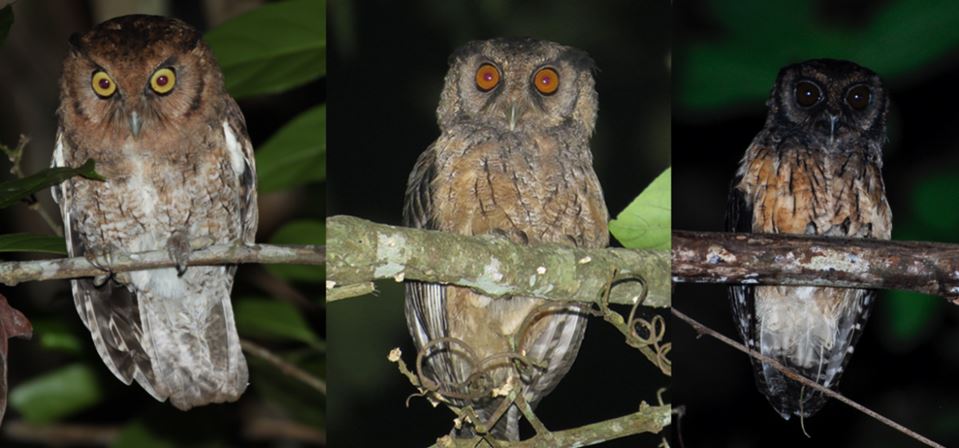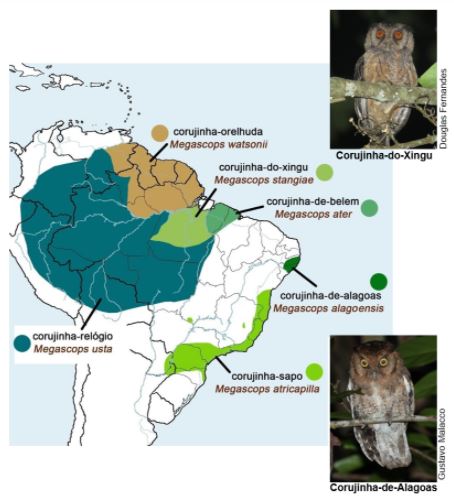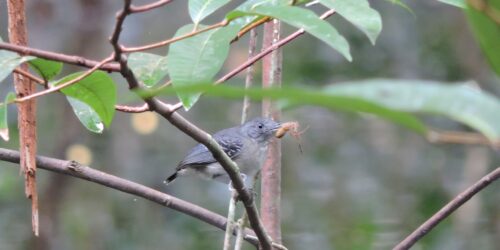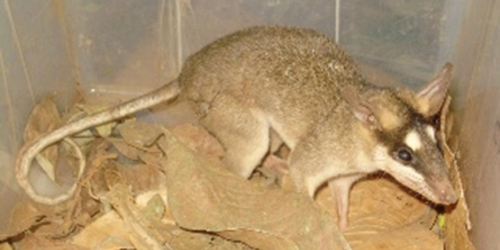Two new species of owls from the Brazilian Amazonia and Atlantic Forest
29 April 2021 | Duration of reading: 6 min
By Sidnei de Melo Dantas
Owls are one of the most popular and recognizable group of birds, which does not mean they are scientifically well known: Because of their nocturnal habits, restricted geographical distribution, and the fact many live in remote and difficult to reach places, many species are hard to study. South America is home to about 50 owl species and few of these are well known.

From left to right: Alagoas screech-owl (Megascops alagoensis, photo by Gustavo Malacco); Xingu screech-owl (Megascops stangiae, photo by Douglas Fernandes); Belém screech-owl (Megascops ater, photo by Lucas Araújo).
The most speciose genus (a group of closely related species) of owls in South America is Megascops, popularly known as screech-owls. About 20 of these species are spread over most of the continent and have very similar plumage. This makes determining how many species there are difficult, and it is possible there are more species than previously thought.
A recent genetic study by Sidnei Dantas and collaborators, in a collaboration between the Museu Paraense Emilio Goeldi in Brazil, and institutions in USA, Colombia and Denmark, suggests that distinct populations of many Megascops may be separate species. This hidden diversity was suspected before genetic data, despite the plumage similarities between the populations. Why? Through differences in the songs between these populations, observed in many species. Thus recognizing differences in songs from populations of the southern tawny-bellied screech-owl (Megascops ustain Brazilian Amazonia led to our study, a taxonomic review of that and two other species, the tawny-bellied screech-owl (Megascops watsonii), also Amazonian, and the black-capped screech-owl (Megascops atricapilla), from the Atlantic forest. Although these species are closely related, prior studies had suggested more species could be involved. And what we found by the end of the study is that the number of species was twice what was previously thought!
In our study, we first looked for genetic differences between populations with distinct songs, and the degree of difference between them. To do this, we extracted DNA from muscular tissue from individuals of the three species. This study would not have been possible without specimens collected on scientific expeditions and housed in biological collections . These specimens allow us to advance research and generate new knowledge.
Our analysis revealed six distinct genetic groups, each one in a different region of Amazonia or Atlantic Forest (see the figure below). Then, we identified differences in morphology (size and coloration) and in the vocalization of the owls, that could distinguish between these six genetic groups. The morphological examination did not reveal many differences between populations both because the populations themselves had similar morphologies, but also because within a single population there was a wide range of individual variation. For example, it is possible to find five or more color patterns in the same population, what makes creating a general description a big headache. However, vocalizations were more useful to tell populations apart, even though many of them have similar songs.

Owl species from the genus Megascops found by the study by Dantas et al. 2021. Map modified from Willian Menq.
With the information from the genetic, morphological and vocal sources, our study proposed the recognition of each of the six genetic lineages as distinct species. Three of these maintained the old scientific names (Megascops watsonii, M. usta and M. atricapilla). One was already described in a paper but not recognized by the scientific community, and had an available name, the Belém screech-owl (Megascops ater). The other two did not have available scientific names, and were therefore described as new species: The Xingu screech-owl (Megascops stangiae), ranging in Amazonia between the Tapajós and Tocantins rivers, and the Alagoas screech-owl (Megascops alagoensis), inhabiting forest fragments in the states of Alagoas and Pernambuco in Brazil. The scientific name of the Xingu screech-owl pays homage to Irmã Dorothy Mae Stang, who fought for social justice for traditional farmers in Amazonia since the 1970s in the Xingu area, and was murdered in 2005.
The newly described species are already potentially threatened by extinction, especially the Alagoas screech-owl, known from five localities whose fragments have little or no connection, isolating the populations even more. The situation of the Xingu screech-owl is better, but its distribution is totally inserted in the Arc of Deforestation, the region with the highest deforestation rate in Amazonia, and this species may be considered threatened in future studies. The Belém screech-owl, by its turn, is endemic to the most deforested region in Amazonia, being also a potential candidate for a threatened status.
This and many other studies concluded or in development, show the extent of underestimation of our biodiversity, even for well-known groups like birds. This also helps to show the threat faced by many species, even those that are not well understood.
Science is done collaboratively
This research was part of Sidnei Dantas ́ PhD in the Museu Paraense Emilio Goeldi/Universidade Federal do Pará, under the advice of Dr. Alexandre Aleixo. It was a partnership between that institution, Field Museum of Natural History em Chicago, USA, and the Academy of Natural Sciences of Drexel University in Philadelphia, USA, under the supervision of Drs. John Bates and Jason Weckstein. The research was financed by the Brazilian Federal Government through CNPq, and by a sandwich doctoral scholarship by CAPES grant/Fulbright.
Want to know more? Access the links below!
History of Dorothy Stang (Link)
Museu Paraense Emílio Goeldi – MPEG (Link)
Artigos científicos:
Dantas et al. 2016. Molecular systematics of the new world screech-owls (Megascops: Aves, Strigidae): biogeographic and taxonomic implications. Molecular Phylogenetics and Evolution, 94, 626-634. (Link)
Dantas et al. 2021. Multi-character taxonomic review, systematics, and biogeography of the Black-capped/Tawny-bellied Screech Owl (Megascops atricapilla–M. watsonii) complex (Aves: Strigidae). Zootaxa, 4949(3), 401-444. (Link)
Research on the news
- Folha de São Paulo: Corujas amazônicas são descobertas, e uma delas é batizada em homenagem a Dorothy Stang (Link)
- Revista Galileu: Estudo descreve novas espécies de corujas da Amazônia e da Mata Atlântica (Link)
- Aventuras na História: Pesquisadores descobrem duas novas espécies de coruja no Brasil (Link)
- Ecoa/Uol: Duas novas espécies de coruja são descobertas nas florestas brasileiras (Link)

Sidnei de Melo Dantas is biologistUFRPE), Master in Ecology (INPA) and PhD in Zoology (MPEG). More information on Lattes and at ResearchGate










